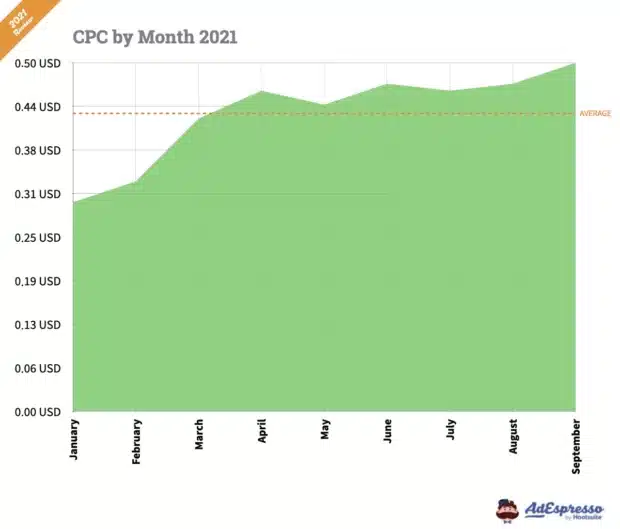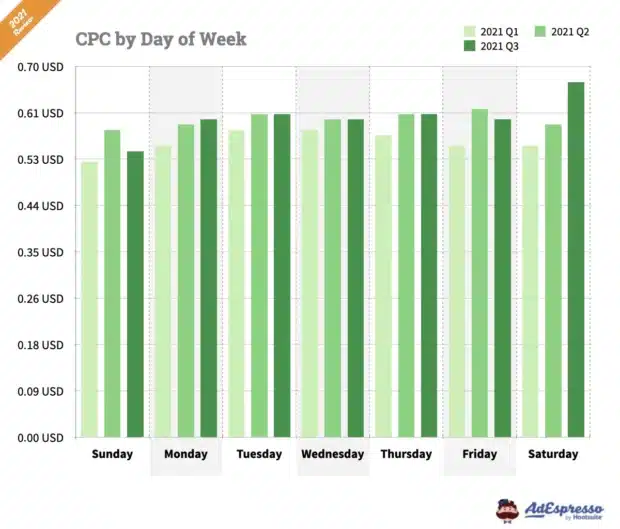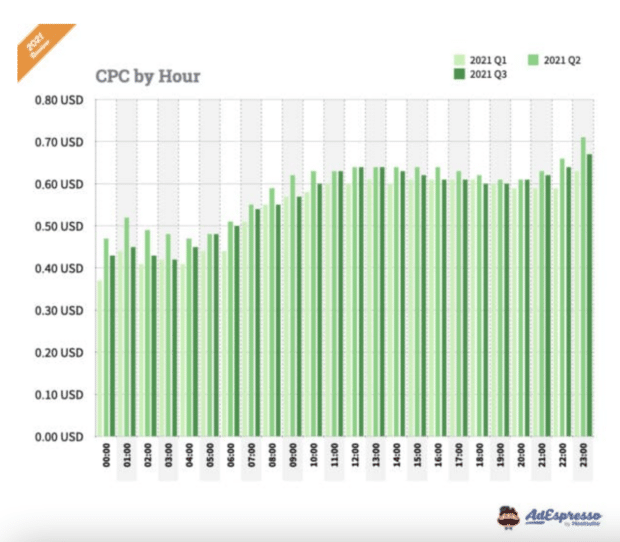7 Simple Ways to Lower Your Facebook Cost Per Click
Did you know that running Facebook cost-per-click advertising campaigns opens up your business to reach a potential audience of 2.11 billion people?
That’s right; Facebook is alive and kicking! Now under the Meta umbrella, Facebook cost-per-click advertising has long been a trusted strategy for growth when combined with organic content.
Savvy marketers know to keep one eye on the bottom line and look for ways to save businesses money. Lowering your Facebook cost-per-click (CPC) is one way to do that, so read on for tips on decreasing your CPC and understanding how to get the most out of your ad campaigns on Facebook.
Bonus: Download a free guide to social advertising and learn the 5 steps to building effective campaigns. No tricks or boring tips—just simple, easy-to-follow instructions that really work.
What is cost-per-click advertising on Facebook?
Facebook cost-per-click advertising is an auction-based marketing strategy where businesses bid to display their ads to a predetermined audience. However, when you use CPC pricing, you’ll only pay when a Facebook user clicks on your ad.
For example, if you’re a fashion brand, you could launch a Facebook cost-per-click campaign to promote your latest product and include a call to action (CTA) that encourages users to click through and shop your latest collection.
Thousands of businesses use Facebook advertising to grow, which is part of the reason an auction and bid-based strategy for Facebook ads is used.
With limited advertising spots on the platform, Facebook considers a variety of factors, including ad total value, quality, and estimated action rates (e.g., will users engage with the ad) to determine which ad gets shown to the specific target audience.
Facebook CPC is calculated as the total amount spent divided by the number of link clicks, and there are a few different cost-per-click campaigns that you can run on the platform. Let’s take a look.
Clicks to visit another website
This one is pretty straightforward. CPC campaigns that drive clicks to a website allow businesses to get more traffic — a great strategy if you’re just starting out and need to get more eyeballs on your product or service.
Call-to-action clicks that go to another website (i.e., “Shop Now”)
Including a specific call to action in your CPC campaigns is a method marketers use to entice their audience to click through to a website or landing page. Common calls to action include language like ‘learn more’, ‘buy now’, or ‘claim offer’.
Notice how these micro sentences always include an action-based word? Using language like this inspires user action, meaning more clicks for your campaign.
Clicks to install an app
This campaign is perfect for businesses who want to generate interest and install an app. For example, let’s say your fashion brand launches a new iOS app that gives your audience the chance to shop through the application. You could run a CPC campaign that focuses on generating clicks to install the app.
Clicks to view a video on another website
Video marketing has been taking social media by storm (hello, TikTok!), so why not leverage the power of video in your CPC campaigns? Using our fashion brand example, you could launch a cost-per-click campaign that encourages your audience to watch a YouTube video on your sustainability practices and how you care about the future of the environment.
What is a good cost-per-click on Facebook?
Now that you’re clued up on how to use cost-per-click advertising on Facebook, you’re probably wondering how CPC campaigns will impact your marketing budget. Luckily, along with our friends at AdEspresso, we’ve crunched the numbers on how much Facebook ads cost and have all the details you need.
Cost-per-click, by month
On a monthly view, it’s common to see a typical range of lower CPCs in Q1 that ramps up to year-high CPCs in Q4. This end-of-year surge is due to Black Friday/Cyber Monday events, holiday shopping, and increased e-commerce advertiser competition.
Cost-per-click, by day of the week
Facebook CPC costs are generally lower on weekends because as more people use social media on Saturday and Sunday, there’s more advertising space available, meaning that you can win auctions at a lower bid price.
Cost-per-click, by time of day
Unsurprisingly, it costs you less to run your campaigns late at night because everyone is asleep. However, we do recommend letting your Facebook cost-per-click campaigns run 24/7 and allow Facebook to maximize your clicks according to your campaign objective.
7 tips to lower your cost-per-click on Facebook ads
If you’re looking to lower your CPC without sacrificing results, you’ve come to the right place. Each of these tips might help you decrease your cost-per-click but remember that each industry and business is different. What drives results for one team might not work for you, so play around and find the formulas that fit your niche and budget.
Nail your campaign objective
Creating a campaign objective is the first step in building a Facebook ad campaign. The campaign objective focuses on the goal you want to achieve from running your ads on Facebook.
Facebook gives you a full roster of different objectives to choose from, including building brand awareness, increasing traffic to your website, generating engagement, landing conversions, and directing traffic to your online store.
Depending on the goal of your ad campaign, you’ll need to match up your own campaign objective with the objectives offered on Facebook. Play around and test which ones get you the best results. For example, if you’re a new business that’s launching with Facebook ads, you’ll likely focus on impressions and reach to help you increase your brand awareness.
Improve your relevancy score
Your relevance score will directly impact your CPC, so it’s important to watch it carefully.
Facebook ads will provide a relevance score on every campaign you run. As the name suggests, this score tells you how relevant your ad is to your target audience.
We don’t know the exact algorithm Facebook uses to calculate the relevancy score, making it a black box metric. Still, we know that positive interactions like engagement, clicks, and saving the ad will improve the score, while hiding the ad will lower the score.
Facebook prioritizes ads with high relevance scores and will actually lower your CPC if your score is on the higher end. Because of this, you should watch your campaigns’ relevance scores and either adjust or stop campaigns with lower scores.
Understand audience targeting
Your main goal of a successful ad campaign on Facebook is to ensure your ad is seen by the right audience at the right time. Understanding audience targeting can help make that happen and actively lower your CPC.
So don’t leave it up to Facebook to choose who sees your ad. Select the location, interests, behaviors, and other demographics to get specific. Narrowing down your target audience helps you bid on who you really want to reach and gives you the opportunity to create more personalized ads that grab their attention (meaning more clicks and conversions for you!)
Think carefully about where you place your ad
Facebook ads can be shown on both mobile and desktop, in newsfeeds, the right-hand column, Instagram (another of Meta’s product suite), Facebook Messenger, and the Facebook Audience Network.
Take some time to understand the best placement for your ad. Will you have a greater impact in the newsfeed or Messenger? Luckily, this is an area that Facebook lets you change after you’ve published your ad, so if you’re finding that your click-through rate is low, go ahead and switch up the ad placement.
Test your ad creative
Testing and iterating on your ad’s creative elements is another tactical way to decrease your cost-per-click. By introducing A/B testing on your Facebook ads, you open up the door to learning which ad creative achieves your campaign goals.
Eric Dyck, CEO at DTC Newsletter, says that his team focuses on velocity when it comes to testing. “The most important aspect of creative testing is velocity, meaning testing multiple creatives every week or every day, depending on your budget. The goal is to find “winners,” or ads that will allow you to scale your campaigns profitably until the creative burns out, which is why you always need to be testing.
The testing framework we use is the Pilot Test, which involves brainstorming five separate angles on the product. Angles are ad concepts built around why a customer might love your product or a problem or pain point your product solves.
With your angles, you also create five related headlines, ad copies, and creative imagery or video. Then you run the creative ad sets head to head and see which one produces the lowest cost-per-click. From there, you can mix and match-winning elements from each ad set to create winning ads with a lower cost-per-click and higher conversion rates.”
Increase your click-through rate (CTR)
Newsflash! Increasing your click-through rate (CTR) will increase your relevance score and lower your Facebook ad costs. Some of the best ways to increase your ads’ CTRs include:
- Always use desktop newsfeed ad placements, which generate higher CTRs
- Use appropriate CTA buttons. “Learn More” will sometimes drive more clicks than “Shop Now” for cold audiences that don’t trust you yet
- Write simple, clean copy that gets right to the point and doesn’t leave users guessing at what they’re clicking on or why they should. (Here are a few examples to get the creative juices flowing!)
- Keep your frequency (or the number of times the same user sees the same ad) as low as possible. If the frequency gets too high, your CTR will fall.
Focus on retargeting
Retargeting is the practice of showing your ads to users who are familiar with your brand and products. Because this is a “warm” audience, they’ll be more likely to interact with or click on your ad, which increases CTRs and lowers CPC.
You can create custom audiences from those who have interacted with your Facebook Page, your site, and your mobile app.
You can even use retargeting to send a follow-up ad to users who’ve previously watched the majority of your video ad that was shown to a cold audience, increasing the likelihood that they’ll click since they’re somewhat familiar with your CPC ad.
You can also use custom audiences from your email list for retargeting. Whether you’re showing ads to users based on their past purchases or past engagement on your site, you’ll know your relationship with them upfront. This can help you create ads and offers they’ll be most interested in.
Manage your Facebook presence alongside your other social media channels using Hootsuite. From a single dashboard, you can schedule posts and videos, engage your audience, and measure the impact of your efforts. Try it free today.
Easily plan, manage and analyze organic and paid campaigns from one place with Hootsuite Social Advertising. See it in action.
Free DemoThe post 7 Simple Ways to Lower Your Facebook Cost Per Click appeared first on Social Media Marketing & Management Dashboard.
Categories
- 60% of the time… (1)
- A/B Testing (2)
- Ad placements (3)
- adops (4)
- adops vs sales (5)
- AdParlor 101 (43)
- adx (1)
- algorithm (1)
- Analysis (10)
- Apple (1)
- Audience (1)
- Augmented Reality (1)
- authenticity (1)
- Automation (1)
- Back to School (1)
- best practices (2)
- brand voice (1)
- branding (1)
- Build a Blog Community (12)
- Case Study (3)
- celebrate women (1)
- certification (1)
- Collections (1)
- Community (1)
- Conference News (1)
- conferences (1)
- content (1)
- content curation (1)
- content marketing (1)
- contests (1)
- Conversion Lift Test (1)
- Conversion testing (1)
- cost control (2)
- Creative (6)
- crisis (1)
- Curation (1)
- Custom Audience Targeting (4)
- Digital Advertising (2)
- Digital Marketing (6)
- DPA (1)
- Dynamic Ad Creative (1)
- dynamic product ads (1)
- E-Commerce (1)
- eCommerce (2)
- Ecosystem (1)
- email marketing (3)
- employee advocacy program (1)
- employee advocates (1)
- engineers (1)
- event marketing (1)
- event marketing strategy (1)
- events (1)
- Experiments (26)
- F8 (2)
- Facebook (64)
- Facebook Ad Split Testing (1)
- facebook ads (18)
- Facebook Ads How To (1)
- Facebook Advertising (30)
- Facebook Audience Network (1)
- Facebook Creative Platform Partners (1)
- facebook marketing (1)
- Facebook Marketing Partners (2)
- Facebook Optimizations (1)
- Facebook Posts (1)
- facebook stories (1)
- Facebook Updates (2)
- Facebook Video Ads (1)
- Facebook Watch (1)
- fbf (11)
- first impression takeover (5)
- fito (5)
- Fluent (1)
- Get Started With Wix Blog (1)
- Google (9)
- Google Ad Products (5)
- Google Analytics (1)
- Guest Post (1)
- Guides (32)
- Halloween (1)
- holiday marketing (1)
- Holiday Season Advertising (7)
- Holiday Shopping Season (4)
- Holiday Video Ads (1)
- holidays (4)
- Hootsuite How-To (3)
- Hootsuite Life (1)
- how to (5)
- How to get Instagram followers (1)
- How to get more Instagram followers (1)
- i don't understand a single thing he is or has been saying (1)
- if you need any proof that we're all just making it up (2)
- Incrementality (1)
- influencer marketing (1)
- Infographic (1)
- Instagram (39)
- Instagram Ads (11)
- Instagram advertising (8)
- Instagram best practices (1)
- Instagram followers (1)
- Instagram Partner (1)
- Instagram Stories (2)
- Instagram tips (1)
- Instagram Video Ads (2)
- invite (1)
- Landing Page (1)
- link shorteners (1)
- LinkedIn (22)
- LinkedIn Ads (2)
- LinkedIn Advertising (2)
- LinkedIn Stats (1)
- LinkedIn Targeting (5)
- Linkedin Usage (1)
- List (1)
- listening (2)
- Lists (3)
- Livestreaming (1)
- look no further than the new yorker store (2)
- lunch (1)
- Mac (1)
- macOS (1)
- Marketing to Millennials (2)
- mental health (1)
- metaverse (2)
- Mobile App Marketing (3)
- Monetizing Pinterest (2)
- Monetizing Social Media (2)
- Monthly Updates (10)
- Mothers Day (1)
- movies for social media managers (1)
- new releases (11)
- News (77)
- News & Events (12)
- no one knows what they're doing (2)
- OnlineShopping (2)
- or ari paparo (1)
- owly shortener (1)
- Paid Media (2)
- People-Based Marketing (3)
- performance marketing (5)
- Pinterest (34)
- Pinterest Ads (11)
- Pinterest Advertising (8)
- Pinterest how to (1)
- Pinterest Tag helper (5)
- Pinterest Targeting (6)
- platform health (1)
- Platform Updates (8)
- Press Release (2)
- product catalog (1)
- Productivity (10)
- Programmatic (3)
- quick work (1)
- Reddit (3)
- Reporting (1)
- Resources (32)
- ROI (1)
- rules (1)
- Seamless shopping (1)
- share of voice (1)
- Shoppable ads (4)
- Skills (26)
- SMB (1)
- SnapChat (28)
- SnapChat Ads (8)
- SnapChat Advertising (5)
- Social (155)
- social ads (1)
- Social Advertising (14)
- social customer service (1)
- Social Fresh Tips (1)
- Social Media (5)
- social media automation (1)
- social media content calendar (1)
- social media for events (1)
- social media management (2)
- Social Media Marketing (49)
- social media monitoring (1)
- Social Media News (4)
- social media statistics (1)
- social media tracking in google analytics (1)
- social media tutorial (2)
- Social Toolkit Podcast (1)
- Social Video (5)
- stories (1)
- Strategy (695)
- terms (1)
- Testing (2)
- there are times ive found myself talking to ari and even though none of the words he is using are new to me (1)
- they've done studies (1)
- this is also true of anytime i have to talk to developers (1)
- tiktok (8)
- tools (1)
- Topics & Trends (3)
- Trend (12)
- Twitter (15)
- Twitter Ads (5)
- Twitter Advertising (4)
- Uncategorised (9)
- Uncategorized (13)
- url shortener (1)
- url shorteners (1)
- vendor (2)
- video (10)
- Video Ads (7)
- Video Advertising (8)
- virtual conference (1)
- we're all just throwing mountains of shit at the wall and hoping the parts that stick don't smell too bad (2)
- web3 (2)
- where you can buy a baby onesie of a dog asking god for his testicles on it (2)
- yes i understand VAST and VPAID (1)
- yes that's the extent of the things i understand (1)
- YouTube (13)
- YouTube Ads (4)
- YouTube Advertising (9)
- YouTube Video Advertising (5)



